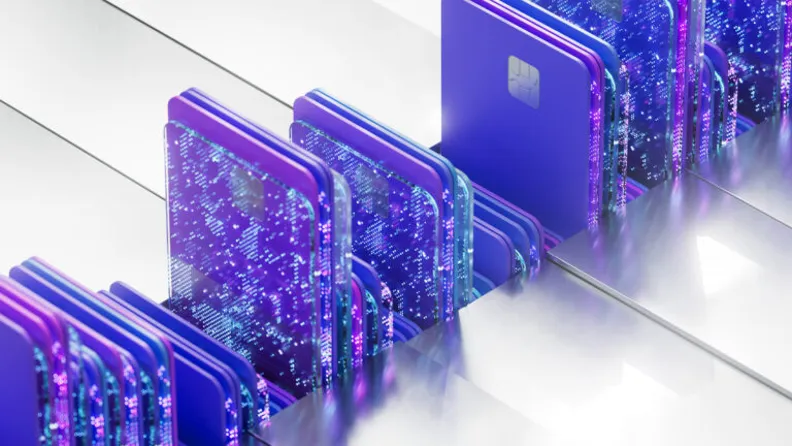The days of hunting around for your credit card may be over. You’ll soon be able to store all your payment methods—credit, debit, bank accounts—in one place, according to credit card giant Visa, which could make physical cards and even credit card numbers obsolete.
It’s all part of the credit card processor’s plan to use generative AI to change the payments landscape. After all, when was the last time you swiped or inserted a credit or debit card to pay for something? According to Visa, global adoption of tap-to-pay is expected to reach 65% by the end of 2023.

“The industry is at a pivotal moment — new technologies like Gen AI are rapidly changing the way we shop and manage our finances,” Jack Forestell, Visa’s chief product and strategy officer, said in a press release.
In addition to enhancing its tap-to-pay capabilities, Visa on Wednesday announced a slew of new payment technologies designed to change the way you make payments across your accounts, including where and how you use your card.
In ten years, you might be using one credential to access all your cards and choose the payment method you want to use. This will include not only credit and debit cards, but also buy now, pay later options and direct payments from your bank account.
Will this be the first step towards the disappearance of physical credit cards?
“It seems like the logical trajectory,” said John Ulzheimer, a credit expert who previously worked at FICO, Equifax and Credit.com. “There are already fully digital driver’s licenses and digital credit cards — like the Apple Card and ApplePay — so why not go fully digital across the board?”
However, some credit card experts expressed caution about the new technology.
“I highly doubt this is any good for consumers or merchants,” said Jason Steele, a member of CNET Money’s expert review board. “Too many online and phone interactions rely on consumers providing merchants with their card numbers. Most consumers find themselves providing their card numbers several times a week to complete transactions.”
Visa’s service is currently available in Asia and is planned to be rolled out to the United States this summer.
Biometric protection for your payments
With Visa Payment Passkey, Visa fights digital fraud and prevents bad actors from using your card to make unauthorized payments.
According to the payment processing giant, fraud occurring in digital transactions is seven times higher than in face-to-face transactions. With Passkey, you can use your unique biometric recognition (face or fingerprint) to confirm online transactions and prevent unauthorized payments.
You’ll go through the online checkout as usual and add your card information. Then an additional screen will pop up asking you to verify your identity with a face or fingerprint scan. Currently, the service is being piloted in the European Union and is scheduled to roll out in North America starting in the third quarter of 2024.
“Biometric confirmation is much harder to crack,” said James Mirfin, senior vice president and global head of risk and identity solutions at Visa.
However, adoption of this technology may vary from person to person.
“There will always be people who are uncomfortable with using any biometric technology, including face recognition, voice recognition, retina scanning technology and fingerprint recognition technology,” Ulzheimer said. “I think two-step authentication will still be needed before the full biometric authentication process is considered AI fraud-proof.”
Gerri Detweiler, a credit expert and member of CNET’s expert review board, said Gen AI could become a big problem when using biometrics to confirm purchases.
“There are serious and legitimate concerns about voice and facial recognition in banking and payment technology,” she said. “However, when we’re talking about credit cards, card issuers and merchants bear a great deal of the risk because consumers have strong fraud protections under federal law.”
Expanding to click-to-pay technology
Visa is also expanding its Tap & Pay feature. Gone are the days of snapping a photo of a card to add it to your digital wallet. Instead, Visa is rolling out technology that lets you tap a card on your smart device to add it to your wallet. You can also tap the card on your phone to confirm the transaction without having to enter any additional information.
As physical card numbers become less important and riskier than using a virtual credit card number for online purchases, it may not be long before credit cards no longer have physical card numbers printed on them.
“I don’t think the shift to numberless cards will happen that quickly,” Detweiler said. “There are still a lot of cardholders who want a physical card with a number or need that information to make certain types of purchases. But we are moving in that direction, and these changes are the beginning.”
How we protect your information
While new technology may help protect you from bad actors, right now you can protect yourself from fraud by:
- Use a virtual card number . A virtual credit card number generates a unique card number for online use. It helps keep your financial data more secure by preventing merchants from storing your credit card information.
- Don’t give out your personal information. Even if you agree to receive text messages from your bank or credit card, they will never ask for your personal or confidential information via text message.
- Consider using an identity theft protection and monitoring service . The best services monitor your personal data for signs of fraud and identity theft. Many services also flag suspicious credit and banking activity.
- Sign up for a free credit monitoring service . Some of these services monitor the dark web for personally identifiable information, such as your Social Security number and email.
Bottom Line
Visa is taking digital payments to the next level while also expanding its popular “tap and pay” feature on its credit cards. Its work on AI fraud detection is designed to add an extra layer of security to online transactions.
But whether these new products will become industry-wide standards remains to be seen. To be truly widespread, banks that issue bank cards and merchants that accept bank cards must adopt these new methods.
“There’s a constant race to innovate between payment networks, brands and issuers,” Detweiler said. “In a year or five years, the way many of us pay will be different.”
The other card networks — American Express, Discover and Mastercard — also need to allow their products to be added to Visa’s flexible credentials to make it truly a one-stop shop for all your card and payment information.
The editorial content of this page is based solely on the objective, independent assessment of our authors and is not influenced by advertising or partnerships. It is not provided or commissioned by any third party. However, we may receive compensation when you click on links to products or services provided by our partners.



